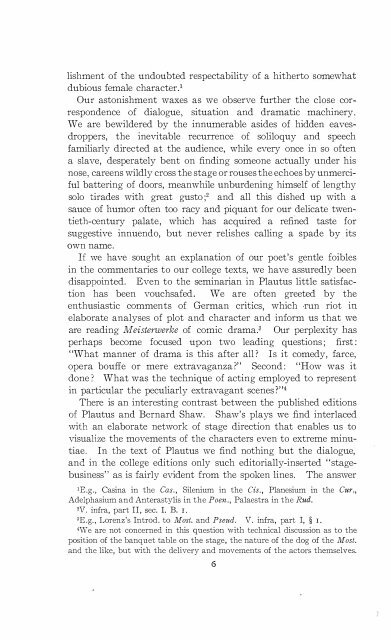Create successful ePaper yourself
Turn your PDF publications into a flip-book with our unique Google optimized e-Paper software.
lishment of the undoubted respectability of a hitherto somewhat<br />
dubious female character.l<br />
Our astonishment waxes as we observe further the close correspondence<br />
of dialogue, situation and dramatic machinery.<br />
We are bewildered by the innumerable asides of hidden eavesdroppers,<br />
the inevitable recurrence of soliloquy and speech<br />
familiarly directed at the audience, while every once in so often<br />
a slave, desperately bent on finding someone actually under his<br />
nose, careens wildly cross the stage or rouses the echoes by unmerciful<br />
battering of doors, meanwhile unburdening himself of lengthy<br />
solo tirades with great gusto;2 and all this dished up with a<br />
sauce of humor often too racy and piquant for our delicate twentieth-century<br />
palate, which has acquired a refined taste for<br />
suggestive innuendo, but never relishes calling a spade by its<br />
own name.<br />
If we have sought an explanation of our poet's gentle foibles<br />
in the commentaries to our college texts, we have assuredly been<br />
disappointed. Even to the seminarian in Plautus little satisfaction<br />
has been vouchsafed. We are often greeted by the<br />
enthusiastic comments of German critics, which ·run riot in<br />
elaborate analyses of plot and character and inform us that we<br />
are reading Meisterwerke of comic drama.3 Our perplexity has<br />
perhaps become focused upon two leading questions; first:<br />
"What manner of drama is this after all? Is it comedy, farce,<br />
opera bouffe or mere extravaganza?" Second : "How was it<br />
done? What was the technique of acting employed to represent<br />
in particular the peculiarly extravagant scenes ("4<br />
There is an intercsting contrast between the published editions<br />
of Plautus and Bcrnard Shaw. Shaw's plays we find interlaced<br />
with an elaborate network of stage direction that enables us to<br />
visualize the movements of the characters even to extreme minutiae.<br />
In the text of Plautus we find nothing but the dialogue,<br />
and in the college editions only such editorially-inserted "stagebusiness"<br />
as is fairly evident from the spoken lines. The answer<br />
IE.g., Casina in the Cas., Silenium in the Cis., Planesium in the Cur.,<br />
Adelphasium and Anterastylis in the Poen., Palaestra in the Rud.<br />
2V. infra, part II, sec. I. B. I.<br />
"E.g., Lorenz's Introd. to Most. and Pseudo V. infra, part I, § I .<br />
4\Ve are not concerned in this question with technical discussion as to the<br />
position of the banquet table on the stage, the nature of the dog of the Most.<br />
and the like, but with the delivery and movements of the actors themselves.<br />
6
















